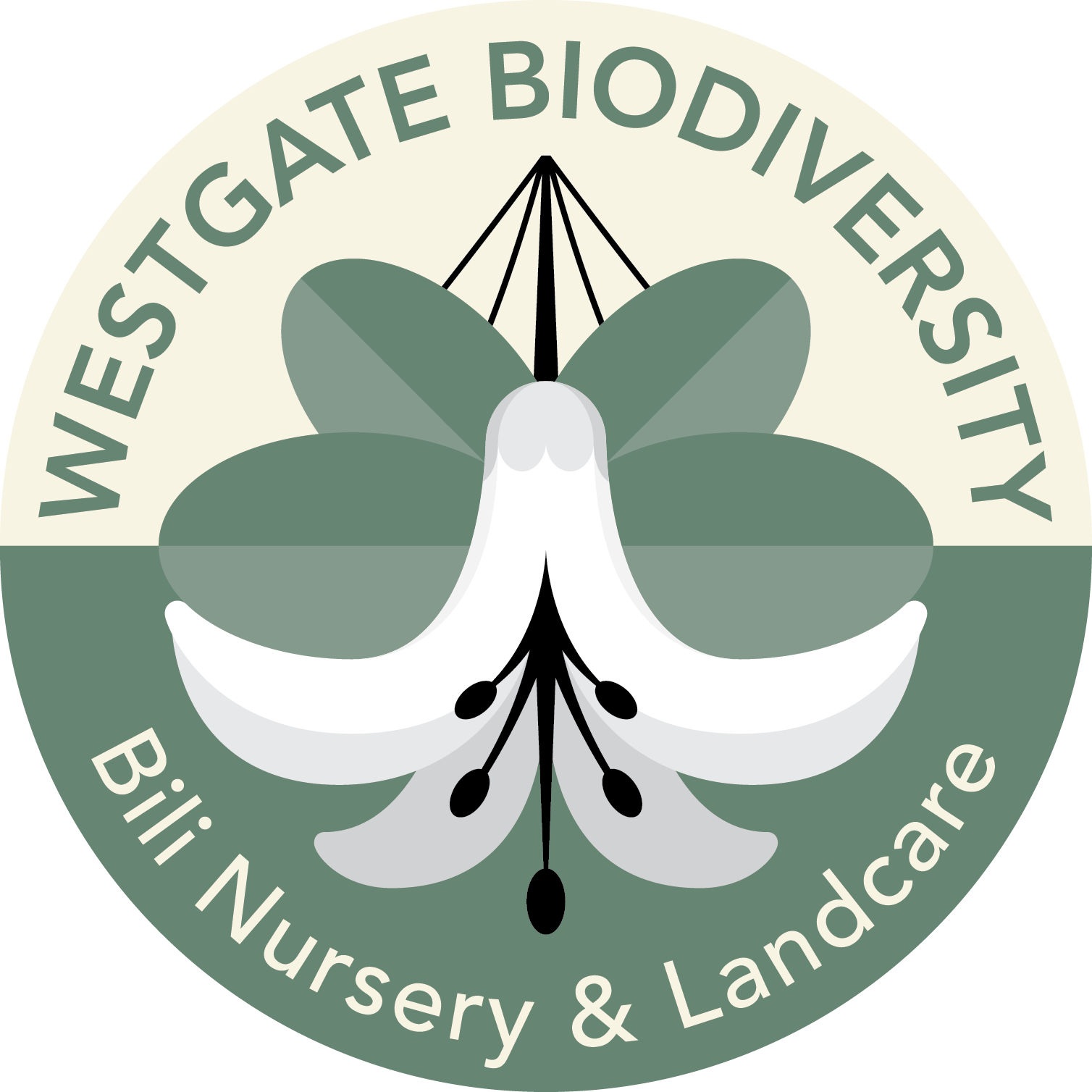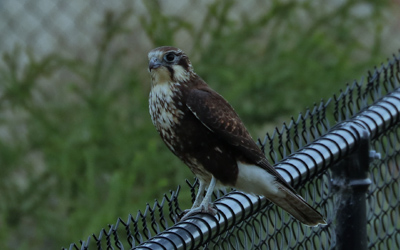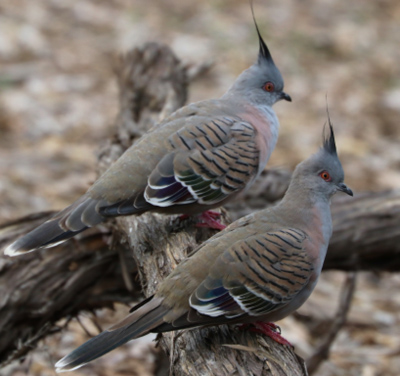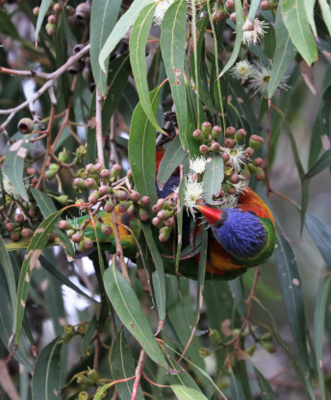May 2018 bird survey
Diving feeders – Hardheads, Australasian Grebes and Hoary-headed Grebes – in better than average numbers suggest aquatic invertebrates and other small prey are plentiful in Freshwater Lake. With levels of both main lakes remaining fairly high, conditions are good for supporting birds.
Visiting nectar feeders, especially Rainbow Lorikeets, Musk Lorikeets and Red Wattlebirds, abound in the park’s large Spotted Gums, which have flowered since April.
Our resident observer recorded a diverse range of visiting raptors during April. One Brown Falcon may be staying on, as it was also seen today in Howe Parade Extension south of the bridge.
The frequency of spoonbill sightings on Freshwater Lake last month provides more evidence of suitable food available for wetland bird species.
Also of interest is the increasing range of honeyeaters in the park, with White-naped Honeyeaters recorded this survey.
| Species | No. seen | Species | No. seen |
| Brown Quail | Galah | ||
| Black Swan | 2 + 6D | Little Corella | |
| Australian Shelduck | Sulphur-crested Cockatoo | ||
| Australian Wood Duck | Rainbow Lorikeet | 65+ (*15) | |
| Pink-eared Duck | Musk Lorikeet | 42 | |
| Australasian Shoveler | Little Lorikeet | ||
| Grey Teal | 2 | Purple-crowned Lorikeet | |
| Chestnut Teal | 28 (*1) | Eastern Rosella | |
| Pacific Black Duck | 22 | Horsfield’s Bronze-Cuckoo | |
| Hardhead | 21 | Fan-tailed Cuckoo | |
| Australasian Grebe | 16 | Sacred Kingfisher | |
| Hoary-headed Grebe | 13 | Superb Fairy-wren | 55+ (7 blue) |
| Rock Dove | White-browed Scrubwren | ||
| Spotted Turtle-Dove | 5 | Brown Thornbill | |
| Crested Pigeon | 6 | Spotted Pardalote | 3 |
| Darter | Striated Pardalote | ||
| Little Pied Cormorant | 4 (*3) | Yellow-faced Honeyeater | |
| Great Cormorant | *1 | White-plumed Honeyeater | 70+ |
| Little Black Cormorant | 2 | Noisy Miner | |
| Pied Cormorant | Spiny-cheeked Honeyeater | 6 | |
| Australian Pelican | 3 | Little Wattlebird | 1 |
| Eastern Great Egret | Red Wattlebird | 90+ (*10) | |
| Cattle Egret | New Holland Honeyeater | 20+ | |
| White-faced Heron | 1 | White-naped Honeyeater | 2 |
| Nankeen Night-Heron | Black-faced Cuckoo-shrike | ||
| Australian White Ibis | White-winged Triller | ||
| Straw-necked Ibis | Golden Whistler | ||
| Royal Spoonbill | Grey Shrike-thrush | ||
| Yellow-billed Spoonbill | Grey Butcherbird | ||
| Black-shouldered Kite | Australian Magpie | 4 | |
| Brown Goshawk | Pied Currawong | ||
| Little Eagle | Grey fantail | ||
| Nankeen Kestrel | Willie Wagtail | 9 | |
| Brown Falcon | 1 | Little Raven | 7 |
| Australian Hobby | Magpie-lark | 10 | |
| Peregrine Falcon | Flame Robin | ||
| Purple Swamphen | 3 | Rose Robin | |
| Buff-banded Rail | Golden-headed Cisticola | ||
| Baillon’s Crake | Australian Reed-Warbler | ||
| Black-tailed Native-hen | Little Grassbird | ||
| Dusky Moorhen | 27 | Silvereye | |
| Eurasian Coot | 120 + 3D | Welcome Swallow | 50+ |
| Black-winged Stilt | 3 | Fairy Martin | |
| Black-fronted Dotterel | 5 | Common Blackbird | 12 |
| Red-kneed Dotterel | Common Starling | 270+ | |
| Masked Lapwing | Common Myna | 6 | |
| Latham’s Snipe | Red-browed Finch | ||
| Crested Tern | *1 | House Sparrow | 1 |
| Pacific Gull | Australasian Pipit | ||
| Silver Gull | 125 (*70+) | European Greenfinch | 3 |
| European Goldfinch | 3 |
Number of Bird Species – Wetland dependent & Raptors 20 Land based 23 Total 43 species
Other animals:Common Froglet heard in dam and How Parade Extension Wetlands, Brush-tailed Possum
* seen at/along Yarra River only. D- Denotes dependent young plus number of separate broods.
Note: For species seen in large numbers, or for which accurate counting was difficult the number seen is rounded off to the nearest of tens or fives followed by a +.
Habitat: The Large Freshwater and Saltwater lakes are at a similar level to the previous month, and conditions in both lakes continue to be good for supporting birds. Diving feeders, comprising Hardheads Australasian Grebes and Hoary-headed Grebes are present in better than average numbers suggesting aquatic invertebrates and other small prey are plentiful in the Large Freshwater Lake.
With a number of Spotted Gums in flower during April and this month there are large numbers of visiting nectar feeders in the park, especially Rainbow Lorikeets, Musk Lorikeets and Red Wattlebirds.
Interesting/notable sightings:
- A diverse range of visiting raptors recorded by George during April. One of them, a Brown Falcon may be staying for a while as it was seen today in the Howe Parade Extension Area south of the big bridge.
- The frequency of spoonbill sightings on the Large Freshwater Lake over the last month are yet more evidence of suitable food available in the lake for a range of wetland bird species.



